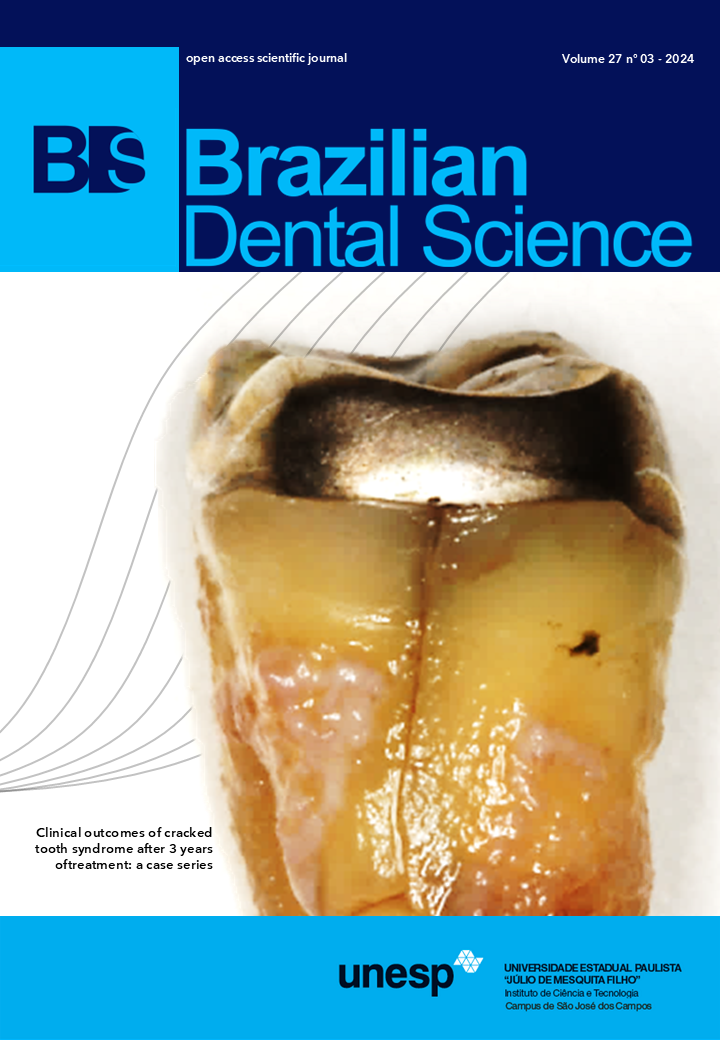Effect of charcoal-containing toothpastes on roughness and color stability of bulk-fill resin composites
DOI:
https://doi.org/10.4322/bds.2024.e4414Resumo
Objective: To evaluate the effects of different commercially available charcoal-based toothpastes (CBTs) on the roughness and color of bulk-fill resin composites (RCs). Materials and Methods: Disc-shaped samples (6 × 2 mm) were made with nanofilled (NF) bulk-fill (Filtek One, 3M Oral Care) or nanohybrid (NH) bulk-fill (Aura, SDI) RCs. The analyses were performed initially (baseline) and after 10,000 brushing cycles in a toothbrushing machine using (n=10): regular toothpaste (Colgate Total 12, Colgate-Palmolive) or three types of CBTs (Colgate Luminous White Activated Charcoal - Colgate-Palmolive; Black is White - Curaprox; 3D White Mineral Clean - Oral-B). The specimens were analyzed for roughness (RA, µm) and quantified by coordinates of the CIEL*a*b* color space, Vita Classical scale (shade guide unit, SGU), and general color alteration (deltaEab; deltaE00). The data were evaluated using generalized linear models (Ra, L*, b*, deltaEab; deltaE00), Mann-Whitney, Kruskal-Wallis, and Dunn tests (a*; deltaSGU), with alpha=0.05. Results: Regardless of the toothpaste, Ra increased after brushing, but was significantly higher in NH than NF (p=0.0001). L* significantly decreased after brushing with Black is White toothpaste (p=0.0027). NF showed higher deltaE00 values after brushing with the CBTs, compared with regular toothpaste. Moreover, NH exposed to Black is White exhibited higher deltaEab and deltaE00 values than the other toothpastes (p<0.0001). Conclusion: The roughness alteration was not mediated by the type of toothpaste. However, the CBTs were able to change the optical properties of bulk-fill RCs, with more pronounced effects, as observed with Black is White.
KEYWORDS
Activated charcoal; Color; Composite resins; Toothbrushing; Toothpastes.
Downloads
Downloads
Publicado
Como Citar
Edição
Seção
Licença
TRANSFERÊNCIA DE DIREITOS AUTORAIS E DECLARAÇÃO DE RESPONSABILIDADE
Toda a propriedade de direitos autorais do artigo "____________________________________________________________________" é transferido do autor(es) para a CIÊNCIA ODONTOLÓGICA BRASILEIRA, no caso do trabalho ser publicado. O artigo não foi publicado em outro lugar e não foi submetido simultaneamente para publicação em outra revista.
Vimos por meio deste, atestar que trabalho é original e não apresenta dados manipulados, fraude ou plágio. Fizemos contribuição científica significativa para o estudo e estamos cientes dos dados apresentados e de acordo com a versão final do artigo. Assumimos total responsabilidade pelos aspectos éticos do estudo.
Este texto deve ser impresso e assinado por todos os autores. A versão digitalizada deverá ser apresentada como arquivo suplementar durante o processo de submissão.




























